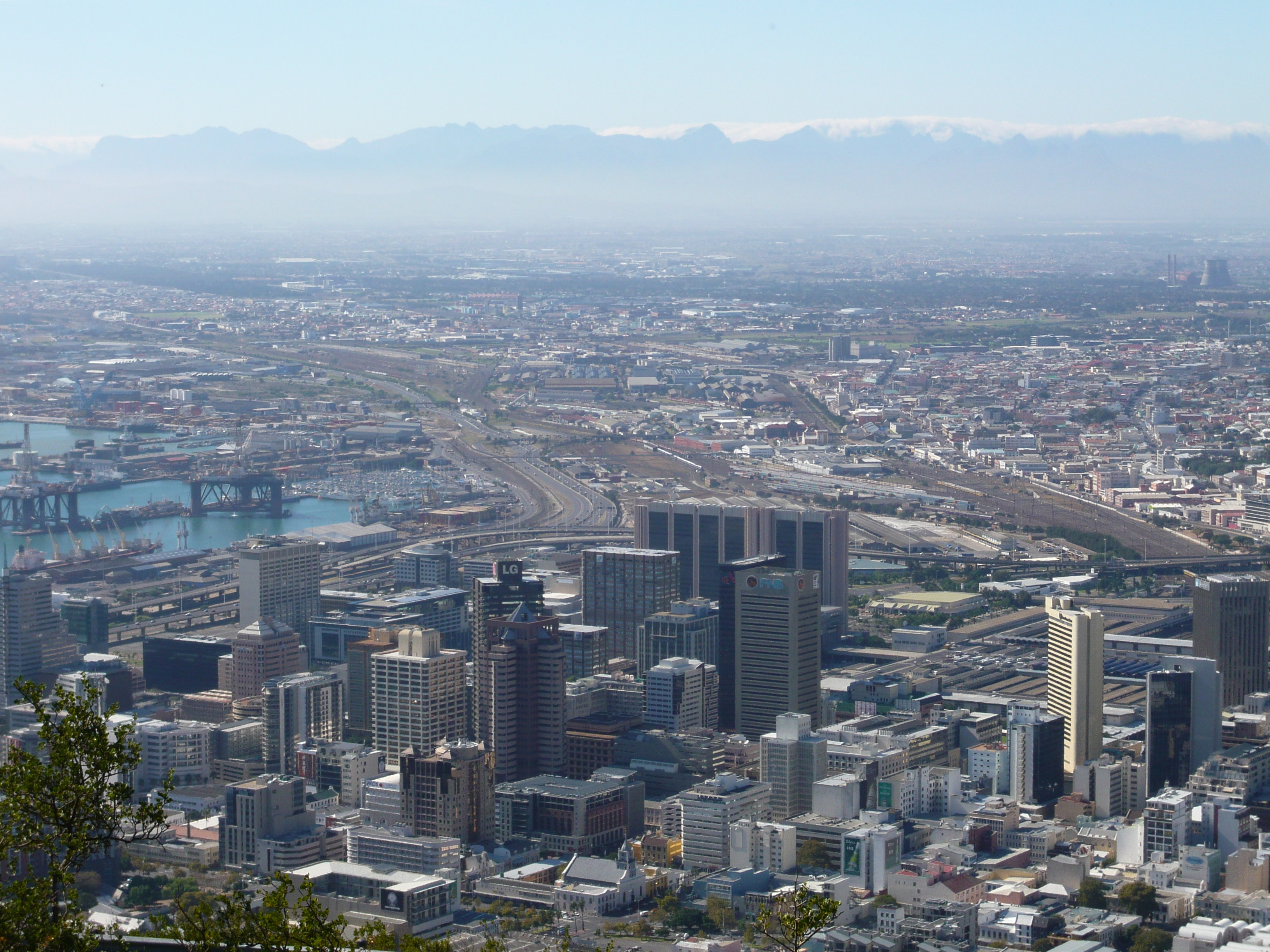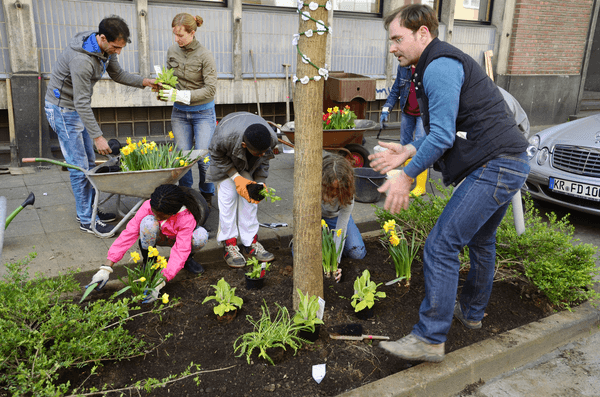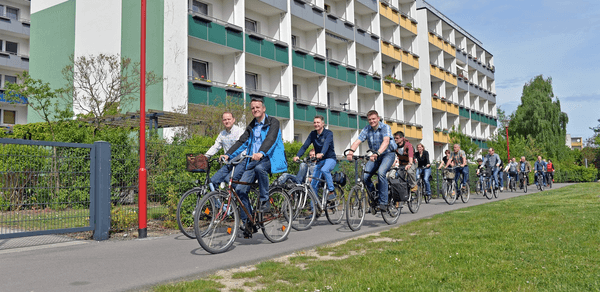 Cape Town Overview - © Andy Carter, (http://www.fotopedia.com/items/flickr-2645741401/slideshow)
Cape Town Overview - © Andy Carter, (http://www.fotopedia.com/items/flickr-2645741401/slideshow) Prefabricated Township Homes in Khayelitsha Township - © Joseph A Ferris III, (http://www.fotopedia.com/items/flickr-5461804042/slideshow)
Prefabricated Township Homes in Khayelitsha Township - © Joseph A Ferris III, (http://www.fotopedia.com/items/flickr-5461804042/slideshow)
City
Cape Town
Main actors
Local Government, Supranational / Intergovernmental Institutions, other
Project area
Neighborhood or district
Duration
Ongoing since 2006
Violence prevention through urban upgrading; using social engagement and town planning as tools in fighting crime.
The Violence Prevention through Urban Upgrading project (VPUU) is an urban planning design strategy in Cape Town Khayelitsha Township, which uses social engagement and town planning as tools in fighting crime. The project is based on the belief that “proper design and effective use of the built environment will lead to a reduction in crime and the fear of crime...”
The project aims to improve living condition for residents through community ‘sub-centres,’ which create employment opportunities, public spaces, and schools. A Social Development Fund upgrades street lighting and sidewalks. Regular organised cultural and social events will contribute to a sense of community and togetherness.
A VPUU satellite centre contributes to a vibrant street life. The highly participatory project focuses on design of public buildings and open spaces to reduce crime. Community involvement comes from the Khayelitsha Development Forum and a local ward development forum. Each development measure begins with a community-based situation analysis which sets out residents’ needs. ‘Spaza’ shops double as safe houses and community patrol bases. They are open 24 hours for anyone who feels threatened.
The project has resulted in a significant decrease crime. In addition, high quality design has improved quality of life and income-generating opportunities.
In February 2001, South Africa President Thabo Mbeki announced the Urban Renewal programme aimed at addressing poverty and under-development in eight identified urban renewal nodes. These nodes represent places where the largest concentrations of urban poor live. Overall Urban Renewal programme objectives are the following:
- addressing poverty and under-development
- achieving increased equity
- encouraging socially cohesive communities
- ensuring integration between spheres of government
One element in overall Urban Renewal programme is Violence Prevention through Urban Upgrading. Violence Prevention through Urban Upgrading in Khayelitsha, Cape Town, has a pronounced focus on integrated urban design and planning which impact on safety and living conditions in township settlements. Khayelitsha is a dormitory town of about 600,000-800,000 inhabitants located about 28 km from Cape Town city centre. It was characterised by increasing crime rates, poverty, high unemployment and high HIV rates. Surveys amongst residents reveal that robbery, murder, rape, and breaking ins are the top four crime categories in the area. In some areas of Khayelitsha, it is perilous, particularly for women, to walk along the dark paths and unlit streets at night. ‘Safe nodes’ or ‘Spazas’ are vitally important. Numerous unemployed persons in Khayelitsha have in effect no way to become self-employed as tradesmen. For women: the risk of being assaulted and robbed is too great. Through the safe nodes, safe commercial premises are made available.
The City of Cape Town implemented in 2006, in partnership with the German government (through KfW, German Development Bank), the Violence Prevention through Urban Upgrading programme. The programme aims not only to reduce crime and increase safety levels but also upgrade neighbourhoods, improve social standards, and introduce sustainable community projects to empower local residents. The project has focused on improvement in areas in the Khayelitsha areas of Harare, Kuyasa, Site C/TR section and Site B to create safe areas for thousands of people (see map below).
The aim is to improve safety by improving the socio-economic situation of about 200,000 – 300,000 residents in defined, ‘safe node’ areas, as they are known, via an area-based approach. This means that dark, neglected and dangerous hotspots are filled with active life through crime-sensitive urban design.
Violence Prevention through Urban Upgrading has a set of safety principles which are used as guidelines in the upgrading/development process, and are in line with principles of crime prevention through environmental design. These include the following principles:
- Surveillance and visibility (‘eyes on the street’): Design in public spaces to have good lighting to ensure maximum public visibility.
- Territoriality (‘owned’ spaces): The sense of ownership which a community has over its environment encourages residents to become involved in reducing crime.
- Defined access and movement: Easy access and well-defined routes into, and through, a public place, help develop a ‘pedestrian’ understanding of that space and perception of safety.
- Image and aesthetics (dignity): A positive image of a place can be achieved by ensuring a ‘human’ scale using appropriate materials, colours, landscaping, and lighting to encourage high levels of public activity.
- Physical barriers: This relates to strengthening building facades and spaces to improve personal safety.
- Maintenance and management (pride and ownership): Well-managed and maintained urban environments encourage a sense of pride and ownership.
Violence Prevention through Urban Upgrading uses specific design ‘tools’ to implement safety principles; these include introducing a clear signage and way-finding system, creating visual connections along walking routes, and ensuring movement routes are as clear and short as possible. These principles and design tools are used in all areas in the upgrading process, to ensure that the main challenge of crime prevention is addressed in the new intervention measure.
The project is based on a model consisting of three ‘pillars’ of development, namely:
- situational crime prevention
- social crime prevention
- institutional crime prevention.
Situational crime prevention refers to the concept of preventing crime through good environmental design. It is assumed that positive changes in the physical environment will ultimately lead to safer communities.
Good environmental design ensures that public space is surrounded by many activities meeting the needs of the surrounding community, as well as ensuring that spaces provide a safe environment due to passive surveillance.
Urban Park Precinct 3 in Harare is an excellent example of this, as it was previously an unsafe open space attracting criminals who robbed people on their way home. The area was identified by community members in 2006 as one of the worst crime hotspots. Through collaboration with local leadership, City of Cape Town professional engineers, and creative design solutions from local professionals, this crime hotspot has now been transformed into a beautiful urban park used by hundreds of residents daily. It has an “Active Box” (The aim of these “Active Boxes” is to positively occupy previously perceived dangerous spaces. The Active Boxes are placed approximately every 500 metres along major pedestrian routes. Volunteer civic patrols guard these buildings. Lights are strategically placed to illuminate the pedestrian route and stay illuminated at night so children can play. Many of the structures have been made by local people; skills needed for this design work form part of the social and institutional crime prevention programmes discussed below.
Social crime prevention promotes a culture of lawfulness, respect, and tolerance. It links social programmes to support victims, prevent violence, and ensures safer spaces are created through the situational crime prevention programme. The main aim of these projects are to prevent and reduce the impact of crime and violence by strengthening relationships between people; drawing vulnerable people into safer conditions and improving the collective capacity of safe node areas for residents to prevent them becoming victims or perpetrators of crime or violence. This programme includes schemes such as Early Childhood Development (ECD), the Social Development Fund (SDF), gender-based violence programmes, the Patrolling Project, legal aid and school-based intervention.
The institutional crime prevention programme is made up of an Operations and Management (O&M) programme and a Local Economic Development (LED) approach, facilitating and encouraging local business as well as having a monitoring and evaluation process. VPUU LED is an area-based approach which aims to build a shared vision, reduce skills gaps, facilitate grass roots / community involvement, improve access to opportunities, and mobilise partners. It also enhances the sustainability of business associations and community organisations’ initiatives. It builds confidence with ‘quick-win’ projects, exploring practical ways to link businesses from the formal and informal economies together, making it harder for crime to be committed.
Funders: City of Cape Town; German Development Bank; provincial and national South African funding; private sector
funding Programme costs: 400 million South African rand/ 55.6 million USD
Numerous aspects contribute to the positive impacts of this project: the most obvious impact is the upgrading of supported areas, resulting in a more beautiful environment which increases the sense of well-being among residents. Residents thus have better access to social, recreational and commercial facilities. From an environmental point of view, personal damage and economic loss is prevented through infrastructure investment in erosion control and flood protection in many settlements. Local governments learned to adapt their services better to local needs, and to open up to community participation in urban development decision making. Ultimately, improved governance within local (and national) authorities thus expands the sphere of influence into formerly illegal and marginalised areas. Programmes led to declined murder and crime rates and the frequency of young offenders.
To sum up VPUU results and impacts:
- Improved safety of residents in Khayelitsha
- Providing victim support and crime prevention services
- Improving residents’ access to social, recreational, and commercial facilities
- Increased capacity and competence in civil society organisations, promoting civil society initiative measures to prevent violence
- Empowering inhabitants through employment and income
- Conflict resolution
- Sustainability via communal service delivery in the safe node areas
The murder rate in the area has declined by one-third since the start of the programme and is now clearly below the national average. The City of Cape Town is currently assessing possibilities of expanding the approach and methodology to other Cape Town areas. Further developments have commenced in other municipal communities.
The following barriers occurred in Khayelitsha; they can be seen in most informal, suburban settlements and should be considered when transferring the project to similar regions.
- Institutional capacity: service delivery is hampered by shortage in human capacity. This has been the case particularly with regard to the health sector in Khayelitsha.
- Coordination between and within spheres of government: challenges are experienced around lack of coordination between sector plans and a degree of resulting ad-hoc, non-strategic investment. Urban renewal is not always a priority within sector planning initiatives.
- Levels of partnership with external stakeholders: there have been challenges with regard to problematic interfaces between certain community organisations and government.
Certain areas requiring further attention within the context of urban upgrading:
- Service delivery focus areas: there are hotspot issues that need to be addressed, particularly around access to basic services, however, the fact that these issues are often multi-dimensional (e.g. health issues are related to environmental aspects and providing dignified living environments as much as to access to appropriate care) means that a similarly multi-dimensional approach is needed.
- Developing effective systems of monitoring and evaluation: there is a need to develop meaningful indicators across sector departments and to coordinate, manage, and make this information accessible for evaluation purposes.
- Strengthening institutional capacity: there is a need to address capacity issues in key areas such as health and improve levels of coordination at the strategic level.
- Strengthening communication: communication efforts need to clarify governmental programmes of action within VPUU and temper unrealistic expectations amongst inhabitants and communities.
Carefully designed programmes can make significant contributions to improving living conditions, enhancing social cohesion, and preventing social violence. However, they cannot ameliorate all forms of crime and violence. Issues of gang-related and organised crime have to be addressed openly by stakeholders at national and international level.
- Political will in authorities to push for and support initiatives is a pre-requisite for programme implementation. Firm support from higher authorities with comprehensive competence, such as mayors, and their personal engagement, has proved to be a key factor for success. In the long run, it will contribute to making slum rehabilitation and integration a permanent part of political urban development strategies.
- Experience over the years has shown that a local management approach, actively including beneficiaries, works best in design, planning, realising, operating, and maintaining facilities.
- The programme participatory character contributes to a sense of identity, trust, cooperation, and ability to drive change among residents and between residents and local authorities.
- However, defining clear roles and responsibilities for all participants, including governments, NGOs, the private sector, and communities, is necessary.
- At the beginning of implementation, managing interdisciplinary and participatory programmes may appear time-consuming. However, the needs orientation in this approach requires an open and flexible programme design which bears fruit when all stakeholders are actively involved in implementation and management. Community development funds, for example, prove to be a useful tool in exercising in managing cooperative self-help activities. They enable residents to take responsibility for realising small-scale projects.
- Violence prevention through urban upgrading programmes is always carried out in a difficult environment. Intervention measures should therefore be based on comprehensive local Peace and Conflict Analysis (PCA) and baseline studies to allow identification of high-risk areas, main conflict lines, and peace-building needs. This enables focusing intervention measures and facilitates decision making during implementation. Implementation should be accompanied by regular peace and conflict-related monitoring (‘do no harm’). Furthermore, crime or violence statistics always comprise dark or grey figures. Sensitisation efforts tend to increase figures, as more inhabitants report cases. Therefore, monitoring systems should include perception indicators with regard to security.
- "Reducing Crime by design" (http://www.sadelivery.co.za/files/back_issues/delivery/Edition22/VPUU%202004.pdf)
- "Violence Prevention through Urban upgrading" (https://www.kfw-entwicklungsbank.de/Download-Center/PDF-Dokumente-Sektoren Berichte/2010_03_Violence-Prevention_E.pdf) - (german)
- Violence Prevention through urban upgrading in Khayelithsa, Cape Town, South Africa.(http://www.germany-wuf4.de/dokumente/15_best_practice/15.01_en_gt01_08-10-22_11-x_-01.pdf)
- KHAYELITSHA COMMUNITY TRUST ANNUAL REPORT 2010/11 (http://www.capetown.gov.za/en/Reports/Documents/Reports%202010-2011/KCT_Annual_Report_2010_11.pdf)
On Map
The Map will be displayed after accepting cookie policy


